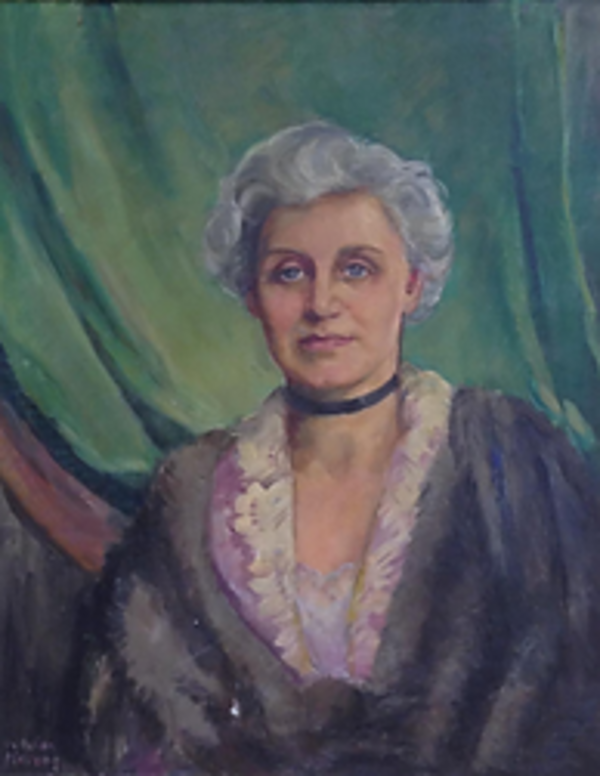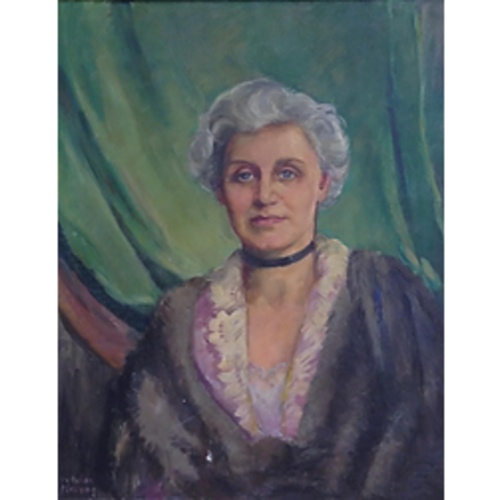
Source: Link
BROWN, ADA MARY (Courtice), educator, social reformer, and office holder; b. 4 Nov. 1860 near Bloomfield, Upper Canada, daughter of Stephen Keyes Brown, a farmer, and Eliza Jane White; m. 24 Oct. 1888 Andrew Cory Courtice in Toronto, and they had a son and a daughter; d. there 24 Aug. 1923 and was buried in Prince Albert, Ont.
The only daughter of devout, humanitarian Quakers, Ada Brown was born on her maternal grandfather’s farm, raised near Pickering, Ont., and educated at Pickering College and the Ontario Ladies’ College in Whitby. She then taught music. In 1886 or 1887 the family moved to Toronto after a split in the Quaker community in Pickering. Although she and her parents later left the Quakers, her Christian faith, characterized by devotion to philanthropic and moral reform, would play a significant role in defining her life’s work.
In 1888 Ada married Andrew C. Courtice, the minister of Parliament Street Methodist Church, where she was a soloist. Subsequent postings took them to London, Montreal, and Kingston. A strong Christian socialist, temperance advocate, and later a pacifist, Andrew was named editor of the Methodist Christian Guardian in 1894 and he, Ada, and their children moved back to Toronto.
From an early date Ada and Andrew, who was removed from his editorship in 1902, were intent on setting up their own school. In preparation, Ada met frequently with kindergarten specialist Adaline Augusta Hughes and her husband, school inspector James Laughlin Hughes*, who together exposed her to progressive educational theories. In 1907 the Courtices opened a school on Howard Avenue with the aim of developing each pupil “physically, mentally and morally” and promoting “self-knowledge, self-control and healthy life.” A year later they founded the Balmy Beach College and School of Music and Art on Beech Avenue, which Ada would operate for ten years after her husband’s death on 10 Nov. 1908.
Strong-willed and resourceful, Ada Courtice had a diverse range of interests. She was an advocate of peace and women’s suffrage and advancement, and was involved with a number of reform organizations, including the National Council of Women of Canada and the Local Council in Toronto. From 1905 to 1913 she convened the National Council’s standing committee on peace and arbitration. Although her attempts to establish subcommittees within local councils across Canada proved disappointing, she held tightly to her pacifist convictions; during World War I she would oppose conscription.
Most of Courtice’s efforts had focused on bettering society by aiding children through improvements in education and family life. She most certainly knew of the movement to form home and school clubs, which, in Ontario, were associated with kindergartens or were organized as art leagues and mothers’ clubs. They tended to favour social events, sports, and fund-raising. At her Balmy Beach school Courtice established a mothers’ club. In 1914 she joined the education committee of the Toronto Local Council and, with its support, ran unsuccessfully for election to the Toronto Public School Board (the highest civic office a woman could hold). Her platform included the use of schools as social centres, improved playgrounds and physical education, more emphasis on vocational education, and better ways to prevent smoking and drinking among boys.
At a meeting of the Local Council on 12 Feb. 1916, on a motion by Courtice, the Toronto Home and School Council was formed. She was elected president, and Ada Hughes honorary president. This council, which included teachers and school officials as well as parents, was distinguished by its early focus on political action and educational reform. Its objectives were to provide a centre for the city’s existing home and school clubs, to study educational issues, and to form “a committee to work in the interests of the municipal elections.” The council was not afraid to criticize schools and lobby for change. It promoted women as candidates in board elections, backed female teachers, supported the expansion of kindergarten, domestic science, and school health programs, and endorsed welfare measures for the poor. In one address to the council, Courtice spoke of its ability “to create interest in standards of home and school life, in a way that few organized efforts can do. It is because the home and school are the rock bottom foundations of individual and national character, that we have faith in our movement.”
In January 1917, with the council’s support, Courtice and Dr Caroline Sophia Brown* secured seats on the school board. For four years Courtice worked to alter curriculum through the addition of French, agriculture, household science, and manual training, and through changes in the physical environment of schools, with an emphasis on more play and athletics. As well, she pushed for special educational facilities for slow learners and the handicapped. Her tenacity is illustrated by her challenge in 1917 of the board chairman’s defence of a principal who had allegedly kissed a female student and by her unflinching support the following year of Freda Held, a teacher whose German parentage attracted vicious wartime abuse.
In May 1919 Courtice called a meeting, under the auspices of the Toronto Home and School Council, to discuss the advisability of forming a provincial body. A loosely organized coalition – of home and school associations, mothers’ clubs, and school and art leagues – soon emerged, known as the Ontario Federation of Home and School Associations. By 1920 it had expanded to include representatives from teachers, inspectors, and women’s institutes. It received a grant from the provincial Department of Education and gained status as a section within the Ontario Educational Association.
Courtice resigned her presidency of the Toronto council in 1920 and assumed the position of organizing secretary for the Ontario Federation. In her annual report for 1921-22 she stressed the importance of homes and schools working together and the democratic underpinning of such joint effort: “We are expressing a type of education not undertaken heretofore in a movement of the people, for and by people themselves, . . . the people of the neighbourhood must find and study their own problems and be able to create public opinion for advancement.” After Courtice was defeated in the school board elections of January 1921, in a wave of reaction, she devoted her attention to the expansion of local home and school clubs. In February the Toronto council established a home education committee, and Courtice agreed to serve as its convenor. It circulated lists of useful books, produced pamphlets for mothers, and distributed material on such topics as scientific budgeting for families and the proper balance of work, rest, and recreation.
By the time of Courtice’s death from intestinal cancer in 1923, some 270 individual home and school associations had been formed throughout Ontario. Within a decade, however, what had started as a reform organization of middle-class women, with lofty ideals to change society through improved childhood education, had become less a challenge to the school system than a vehicle for accommodating accepted practices.
AO, RG 80-5-0-165, no.14443; RG 80-8-0-911, no.4675. LAC, RG 31, C1, 1901, Toronto, Ward 4, div.4: 9 (mfm. at AO). Globe, 11 Nov. 1908. L. M. Burgoyne, A history of the home and school movement in Ontario ([Toronto, 1934?]). Canadian annual rev., 1916: 425. Canadian men and women of the time (Morgan; 1898). T. [A.] Crowley, “Ada Mary Brown Courtice: pacifist, feminist and educational reformer in early twentieth-century Canada,” Studies in Hist. and Politics ([Lennoxville, Que.]), 1 (1980): 76-114; “Parents in a hurry: the early home and school movement in Ontario,” Social Hist. (Ottawa), 19 (1986): 323-42. Kari Dehli, “For intelligent motherhood and national efficiency: the Toronto Home and School Council, 1916-1930,” in Gender and education in Ontario: an historical reader, ed. Ruby Heap and Alison Prentice (Toronto, 1991), 147-63. Alison Prentice et al., Canadian women: a history (Toronto, 1988), 183. T. P. Socknat, Witness against war: pacifism in Canada, 1900-1945 (Toronto, 1987). Veronica Strong-Boag, “Peace-making women: Canada, 1919-1939,” in Women and peace: theoretical, historical and practical perspectives, ed. Ruth Roach Pierson (London, 1987), 170-91. Toronto Home and School Council, Year-book, 1927/28.
Cite This Article
Nancy Kiefer, “BROWN, ADA MARY (Courtice),” in Dictionary of Canadian Biography, vol. 15, University of Toronto/Université Laval, 2003–, accessed January 1, 2026, https://www.biographi.ca/en/bio/brown_ada_mary_15E.html.
The citation above shows the format for footnotes and endnotes according to the Chicago manual of style (16th edition). Information to be used in other citation formats:
| Permalink: | https://www.biographi.ca/en/bio/brown_ada_mary_15E.html |
| Author of Article: | Nancy Kiefer |
| Title of Article: | BROWN, ADA MARY (Courtice) |
| Publication Name: | Dictionary of Canadian Biography, vol. 15 |
| Publisher: | University of Toronto/Université Laval |
| Year of publication: | 2005 |
| Year of revision: | 2005 |
| Access Date: | January 1, 2026 |



